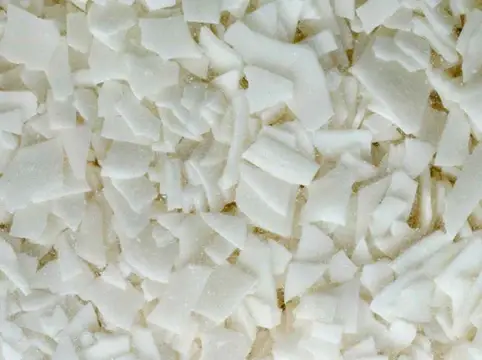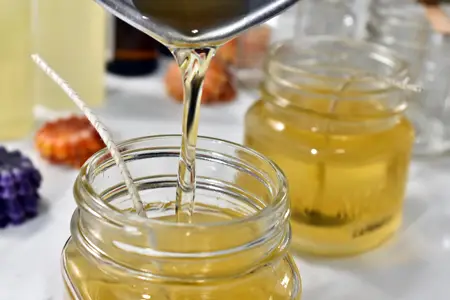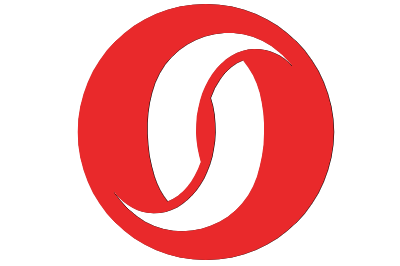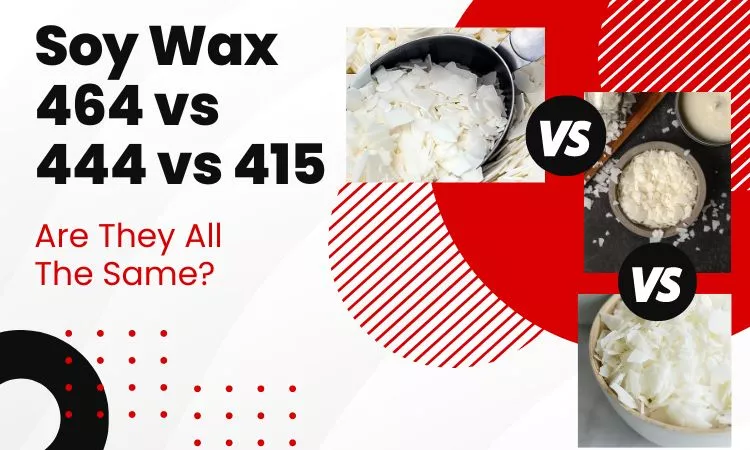As you may already know, there are different types of soy waxes for candle making. Soy wax 464, 415, and 444 are some popular choices.
But is there any difference between soy wax 464 vs 444 vs 415?
Soy wax 464 is the better choice for making container candles due to its high fragrance retention and smooth appearance. Soy wax 444, on the other hand, is well-known for its max fragrance load. Lastly, soy wax 415 is ideal for making candles that require a smooth finish. Also, it has decent fragrance retention properties like 444.
We will be discussing their characteristics in the next part in detail.
Soy Wax 464 vs 444 vs 415: The Key Differences
Here we have gathered all the key comparing factors within a table for you to take a look at-
| Factors | Soy Wax 415 | Soy Wax 444 | Soy Wax 464 |
| Type of Wax | Natural Pure Soy Container Wax | Natural Enhanced Soy Container Wax | Natural Enhanced Soy Container Wax |
| Melt Point (°F) | 120 – 125 | 120 – 125 | 115 – 120 |
| Max Fragrance (%) | 8 – 10 | 9 – 11 | 7 – 9 |
| Suggested Pour Temp (°F) | 90 – 100 | 125 – 145 | 125 – 145 |
| Appearance | Smooth and opaque | Smooth and opaque | Smooth and opaque |
| Flash Point (°F) | >600 | >600 | >600 |
| Price | $32.7 | $33.4 | $29.87 |
Now, we will be moving on to detailed discussion.
Type of Wax:
Soy Wax 415 is classified as Natural Pure Soy Container Wax. On the other hand, both Soy Wax 444 and 464 are categorized as Natural Enhanced Soy Container Waxes.Soy Wax 415 is made solely from pure soybean oil without any additional enhancements or additives. It offers a natural and clean option for candle making.
But despite 444 and 464’s soybean oil bases, they’ve additives that reduce frosting, improve fragrance retention, or enhance glass adhesion.

The use of additives in Soy Wax 444 and 464 allows for greater customization and control over specific candle-making aspects. But for its natural pureness, Soy Wax 415 doesn’t have any additive and thus don’t offer these customizations.
Winner: Soy Wax 464 and 444 wins.
Melt Point:
Soy Wax 415 and 444 have a similar melt point range of 120°F – 125°F. On the other hand, Soy Wax 464 has a melt point range of 115°F – 120°F.
The difference in melt points can have practical implications when it comes to candle-making. A lower melt point, like that of Soy Wax 464, can be advantageous. It allows for easier melting and blending with other ingredients.
It also aids in achieving better glass adhesion, resulting in fewer wet spots on the container candles. However, candles made with lower melt point waxes may have a slightly softer consistency, particularly in warmer environments.
Alternatively, Soy Wax 415 and 444 have similar melt points, making them suitable for applications requiring a higher melting temperature. This characteristic allows these waxes to retain a higher fragrance oil load.
Winner: For easier melting- 464, and for higher fragrance retention- 415 and 444.
Fragrance Load:
Soy Wax 415 has a maximum fragrance load of 8-10%, while 444 offers 9-11%, and 464 provides 7-9%.
These differences indicate the varying capacity of each wax to hold fragrance oils. Soy Wax 444 stands out with the highest maximum fragrance load range of 9% to 11%.
The increased fragrance load allows for a more intense and long-lasting aroma when the candle is burned. By using this wax, candle makers can add a higher concentration of fragrance oils to achieve a stronger scent throw.
On the other hand, Soy Wax 415 offers a slightly lower maximum fragrance load range of 8% to 10%. But it still delivers a satisfying scent throw when lit. Soy Wax 464, although having the lowest maximum fragrance load range of 7% to 9%, should not be overlooked.
Despite the lower range, this wax provides better glass adhesion and minimizes wet spots on containers. Besides providing a pleasing scent experience, it enhances the burning performance and appearance of the candles.
Winner: Soy Wax wins 444 for its max fragrance load.
Pour Temp:
Soy Wax 415 has a lower pour temperature range of 90°F – 100°F compared to the other two waxes. But, both Soy Wax 444 and 464 have a higher suggested pour temperature range of 125°F – 145°F.
For its lower pour temp, it’s recommended to pour the melted 415 into containers at a relatively lower temperature. The lower pour temperature helps in achieving a smoother finish and reduces the likelihood of surface imperfections.

On the other hand, higher pour temperatures are beneficial for 444 and 464. Because they enhance adhesion to the container walls and minimize potential issues. For example, wet spots or poor glass adhesion.
These soy waxes are relatively easy to work with. But you still must know how to transfer wax from one cart to another.
Winner: 415 for a smoother finish, or 464 and 444 for better adhesion.
Appearance:
The appearance of all three soy waxes, Soy Wax 415, 444, and 464, is described as smooth and opaque. However, there is a slight difference in their finishing characteristics.
In addition to its smooth and opaque appearance, Soy Wax 464 reduces wet spots and aids glass adhesion. Thus, candle makers may experience fewer issues with wax not adhering well to containers when using Soy Wax 464. This will result in a more visually appealing candle.
That’s why top candle brands like Yankee Candles and Kringle Candles use soy waxes as their primary ingredients.
Also, for all three soy waxes, Golden Brands 415, 444, and 464 are recommended including ECO Wicks or CD Wicks.
Winner: 464 for better glass adhesion.
Flash Point:
All 415, 444, and 464 soy waxes have a flash point greater than 600°F.
A substance’s flash point is an important safety parameter that indicates the minimum temperature at which it can ignite. The flash point of greater than 600°F indicates that these waxes can withstand high temperatures without the risk of combustion
Result: Tie
Price:
Soy Wax 464 is the cheapest of the three, while Soy Wax 444 is the priciest.
Let’s have a look at the prices of Soy Wax 415, 444, and 464 for different product bundles.
| Soy Wax | Price for 10 lb Bag | Price for 45 lb Bag | Price for a Pallet (36 cases) |
| Soy Wax 415 | $32.70 | $113.85 | $3,985 |
| Soy Wax 444 | $33.40 | $115.65 | $4,050 |
| Soy Wax 464 | $29.87 | $116.51 | $3,985.2 |
So, you see that the price is not so different among these three soy waxes. Choose one with your preference.
Soy Wax 464 vs 444 vs 415: Better Option For Candle Making!
While Soy Wax 415 and 464 are popular choices for container candles, Soy Wax 444 is popular for tealights.
Golden Brands 444 offers a higher maximum fragrance load. But Golden Brands 415 is ideal for those who prefer a lower melt point. Golden Brands 464 is known for its better glass adhesion and reduced wet spots.
Ultimately, the choice will depend on factors such as desired fragrance intensity, pouring temperature, appearance preferences, and specific candle-making goals.
Frequently Asked Questions (FAQs):
What Is 415 Soy Wax Used for?
GW 415 soy wax is specifically designed for use in container candles. It is well-suited for blending with other waxes, such as paraffin and beeswax. GW 415 soy wax is primarily used in container candles, where it provides smooth, opaque appearances.
Can I Use Soy 444 for Wax Melts?
Yes, 444 Soy Wax can be used for wax melts. However, it may have a crumbly consistency, which can affect the performance and quality of the wax melts. Therefore, it is recommended to conduct a test before using 444 for wax melts.
What Is The Best Fragrance Load for 464?
The best fragrance load for Soy Wax is typically around 6% of the total wax weight. That means approximately 1 ounce of fragrance oil per pound of wax. While 464 has a maximum fragrance load of 10%, it may not always be necessary or ideal to use it.
Conclusion
After discussing the comparison of soy wax 464 vs 444 vs 415, you now know which one to use. It’s important that you use these waxes based on their distinctive features to get the best result.

